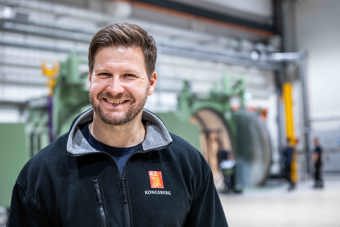
Aircraft Mechanic – A Growing Demand
As a part of our department Aerostructures & MRO, Kongsberg Aviation Maintenance Services (KAMS) performs maintenance, modification, repair, and upgrade of aircraft, helicopters, engines, components, and field equipment for the Norwegian Armed Forces and other military and civilian customers.
-
Text:Amanda Chapman-Stavn / KONGSBERG
Photo:Magnus Bjørnnes / KONGSBERG
The history of KAMS extends back to 1916, marking its inception as a pivotal player in Norway's aviation industry.
In a landmark move in 2019, KONGSBERG, as the majority owner, along with Patria, acquired the company, setting the stage for KAMS to emerge as a leader in the global MRO (Maintenance, Repair, and Overhaul) market.
In the same pivotal year, KAMS and the Norwegian Defence Logistics Organisation (NDLO) forged a strategic partnership aimed at expanding the maintenance capabilities for military aircraft and helicopters.
With more than 470 employees, spread across six different locations: Kjeller, Rygge, Bardufoss, Bodø, Ørland and Evenes, KAMS boasts extensive MRO capabilities. This encompasses component testing for military aircraft and helicopters. MRO ensures that platforms and components remain up-to-date for utilization throughout their lifespan. The ability to maintain these platforms without the need for new production also yields significant environmental benefits.
"Pursuing a career as an aircraft mechanic encompasses a diverse set of requisite skills.
I have the privilege of working on the AW101, an aircraft designated for rescue operations. Knowing that the helicopter contributes significantly to life-saving missions is incredibly rewarding."
- Andreas, aviation technician at KAMS.
Join the Ranks of Aircraft Mechanics
Every year, KAMS welcomes a group of ambitious apprentices. The last two years, 14 young and hopeful individuals have been accepted at KAMS, and all of them have been offered permanent positions following the completion of their apprenticeship.
"The future demand for aircraft mechanics is significant. Each year, we conduct various school visits and participate in career days to assist today's youth in making an important decision. Having the opportunity to introduce them to a new career path is a great honor," explains Linn Løken, HR advisor at KAMS.
In Norway, aviation studies are offered at five secondary schools: Bardufoss, Bodø, Skedsmo, Fosen, and Sola. Students begin their journey with a foundation in Electrical Studies or Technology and Industrial Sciences (TIF), progressing to specialized aviation studies. Here, they face a choice between focusing on flight engineering or avionics. Upon completing this specialized track, they emerge ready to start their apprentices.
We are currently expanding our depot at Rygge, where we are establishing an F-35 National Air Vehicle Depot. As part of this expansion, we will have requirements across various aircraft mechanic specialties, including systems, avionics, structures, as well as other areas such as engineering and logistics. Similar needs will arise at KAMS' facilities in Bardufoss, Bodø, Ørland and Evenes.
Are you considering a career in aviation and aircraft maintenance? Discover the insights into the daily routines of KAMS' talented and motivated staff who specialize in working on aircraft, helicopters, engines, and various components.
Safety is Crucial
21-year-old Andreas works as an aviation technician on the AW101, also known as the SAR Queen. He has been working at KAMS since his apprenticeship. He describes his first encounter with the helicopter as complex and powerful.
"I quickly realized there was so much to learn. I'm especially impressed by the technology and the maintenance. It's a multifaceted experience to work with helicopters," Andreas explains.
He started at KAMS as an apprentice when he was 18 years old. The young apprentice followed his gut feeling and quickly realized that the aviation line of study was the right choice for him. This decision was driven not only by the attractiveness and demand for such expertise but also by his passion for tinkering and maintenance, which he could put into practice.
"The fact that it was helicopters was purely coincidental," the young aviation technician explains. "I've performed various modifications and repairs on helicopters, from the Sea King to the AW101. Seeing the helicopter you've worked on, in action on the news, is incredibly rewarding. Contributing to saving lives provides a meaningful work environment.
Being an aircraft systems mechanic demands a wide range of skills. Andreas highlights patience and communication as particularly important qualities.
"Furthermore, a commitment to quality and having the right mindset are essential. We must work in organized conditions, ensuring that what we deliver can operate safely. The latter is crucial. "
With a Passion for Aircraft Mechanics
Jonas is a young skilled worker with a passion for aircraft mechanics. The 23-year-old has spent the last few years delving into the complexity of F-16 fighter jet engines.
"My work focuses on the maintenance and overhaul of F-100 engines, which involves disassembling the entire engine, inspecting parts, replacing those that are needed, and repairing what can be fixed."
"We rely heavily on 'Technical Orders' to determine what we can use and what we can't. If the parts can be repaired, we do so; otherwise, we order new ones. It varies a lot; sometimes we just swap out parts on the engines." He adds that the timeframe for an engine overhaul can range from three to six months, depending on the scope of the work.
The skilled worker's path to becoming an aircraft mechanic was both traditional and unique. After serving as an apprentice at KAMS from 2019 to 2021, he took a turn in his career. "In January 2022, I went to Belgium for a different kind of service in a NATO position I had previously applied for," he explains. After a year and a half in Belgium, he returned to KAMS in the summer of 2023. The choice to work at KAMS came naturally to Jonas - the opportunity to work with important military equipment.
"The best aspect of the job is the excitement and enjoyment it brings, along with the strong camaraderie among colleagues," he reflects. "Meeting EASA requirements requires hard work and passing numerous exams, with a minimum score of 75%."
Jonas's interest in aircraft began in his early years, alongside a curiosity for disassembling and reassembling objects. His enthusiasm was further nurtured by a family friend who is an aircraft mechanic.
"It's satisfying to see the engine you've worked on for so long installed in a plane leaving the base. That's when you really see that the effort of your work pays off."
High Standards and Rewarding Work
"I've always been interested in aircraft. Working with avionics demands higher standards than traditional electrical work and requires a lot of expertise," Odin says.
He is a young and ambitious apprentice, well on his way to specializing in avionics for F-16 fighter jets. After studying aviation in Bodø, his journey led him to KAMS, where he is currently undergoing his apprenticeship.
"In the beginning, I learned a lot from manuals and frequently followed a skilled worker. Now, I handle many tasks independently but seek assistance when necessary. Success in this field largely hinges on personality traits and motivation. As an avionics technician, the role encompasses diverse responsibilities, ranging from wiring to testing the aircraft's systems, which include communication devices and radars."
With the trade exam scheduled this fall, Odin is looking forward to completing the apprenticeship, with a clear desire to continue his career journey with KAMS.
"Here, the level of competence is high, the work culture is excellent, and the leadership is genuine. That's important to me," he emphasizes.
"At KAMS, we operate with a JUST culture, which focuses on the cause of errors rather than blaming individuals. This approach is crucial for learning, development, and fostering a positive culture. I take pride in the work I do. It's rewarding to contribute to putting Norway on the map through important work."


